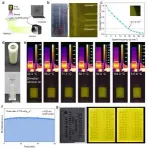(Press-News.org) In the realms of material inspection, medical diagnostics, astronomical discovery, and scientific research, the demand for high-resolution and ultrastable X-ray imaging methods has ignited a fervent pursuit of innovative X-ray-responsive materials. These sought-after materials must possess exceptional qualities such as high X-ray attenuation, efficient scintillation, rapid light decay, and robust durability. Among them, lead-halide-based perovskites have emerged as a compelling contender due to their remarkable luminescence efficiency, superior X-ray attenuation capabilities, and short fluorescence lifetimes. However, their application in the scintillation field is hindered by the toxicity of heavy metal lead (Pb), low photon yield caused by self-absorption effects, and poor X-ray irradiation stability.
Breaking barriers: Lead-free anti-perovskite nanocrystals
To overcome these challenges, researchers have sought solutions in lead-free zero-dimensional (0D) metal halides, such as copper-, silver-, zirconium-, and manganese-based halides. These intriguing alternatives have shown promise as effective scintillators for X-ray detection and imaging, boasting high photon yields, diverse composition and structure options, and a unique luminescence mechanism known as self-trapped excitons (STEs). However, a major hurdle lies in the fabrication of these metal halides as thin films or wafers, resulting in subpar imaging resolution due to light scattering caused by large particles and crystal boundaries. Additionally, lead-free 0D metal halides face challenges related to poor stability, particularly in hot and humid environments.
In an astounding breakthrough reported in Advanced Photonics, researchers from South China University of Technology developed a pioneering approach that revolutionizes X-ray imaging. They accomplished high-resolution and ultra-stable X-ray imaging even in demanding conditions of high temperature and humidity. The key: lead-free Cs3MnBr5 anti-perovskite nanocrystals embedded within a glass matrix.
Unlike traditional perovskite materials, anti-perovskites possess a distinctive structure represented as [MX4]XA3 [A = alkali metal; M = transition metal; and X = chlorine (Cl), bromine (Br), and iodine (I)]. This unique configuration features a luminescence center, the [MX4]2- tetrahedron, nestled within a three-dimensional (3D) XA6 octahedral anti-perovskite skeleton. This structure significantly reduces the interaction of the luminescence center, fostering enhanced spatial confinement effects and ultimately yielding high quantum efficiency and luminescence stability.
Through the process of in-situ crystallization during annealing, Mn2+ ions are seamlessly integrated into the glass matrix, giving rise to tunable luminescence colors ranging from red to green, as dictated by the annealing schedule. Moreover, the Cs3MnBr5 nanocrystal-embedded glass exhibits unparalleled X-ray irradiation stability, thermal stability, and water resistance. Remarkably, it also boasts an exceptional X-ray detection limit (767 nanograys per second), an impressive X-ray imaging spatial resolution (19.1 line pairs per millimeter), and outstanding X-ray dose irradiation stability (5.775 milligrays per second).
This groundbreaking work presents an intriguing new scheme that harnesses the potential of transparent glassy composites incorporating lead-free anti-perovskite halide nanocrystals for high-resolution and ultrastable X-ray imaging applications. The results of this research could serve as a catalyst, stimulating further exploration and development of novel metal halide anti-perovskite materials. Ultimately, this discovery paves the way for the future development of next-generation X-ray imaging devices, promising transformative advancements in the field of X-ray diagnostics and imaging.
Read the Gold Open Access article by Le, Huang, et al., “Transparent glassy composites incorporating lead-free anti-perovskite halide nanocrystals enable tunable emission and ultrastable X-ray imaging,” Adv. Photon. 5(4) 046002 (2023), doi 10.1117/1.AP.5.4.046002.
END
Illuminating the future of X-ray imaging: High-resolution and ultrastable solutions with lead-free anti-perovskite nanocrystals
Researchers harness transparent glassy composites incorporating lead-free nanocrystals in a pioneering approach that revolutionizes X-ray imaging
2023-07-10
ELSE PRESS RELEASES FROM THIS DATE:
DOE announces $72 million for small business research and development grants
2023-07-10
WASHINGTON, D.C. — The U.S. Department of Energy (DOE) today announced $72 million in funding for small businesses to pursue scientific, clean energy, and climate research, development, and demonstration projects. The funding will support 296 projects across 44 states and addresses multiple topic areas, such as renewable energy, nuclear energy, cybersecurity, advanced materials and manufacturing, microelectronics, and artificial intelligence. Today’s announcement underscores the Biden-Harris Administration's deep commitment to advancing innovative climate solutions and strengthening America’s ...
Personalized oral cancer survival calculator to estimate risk of death from oral cancer or other causes
2023-07-10
About The Study: The models developed for the Surveillance, Epidemiology, and End Results Oral Cancer Survival Calculator demonstrate that survival estimates that exclude the effects of coexisting conditions can lead to underestimates or overestimates of survival.
Authors: Louise Davies, M.D., M.S., of the Department of Veterans Affairs Medical Center in White River Junction, Vermont, is the corresponding author.
To access the embargoed study: Visit our For The Media website at this link https://media.jamanetwork.com/
(doi:10.1001/jamaoto.2023.1975)
Editor’s Note: Please ...
Key points for clinicians about the SEER oral cancer survival calculator
2023-07-10
About The Article: This article describes the Surveillance, Epidemiology, and End Results Oral Cancer Survival Calculator, which is designed to provide patient-specific survival estimates based on the severity of an index cancer as well as the competing risk of death of other comorbid ailments.
Authors: Louise Davies, M.D., M.S., of the Department of Veterans Affairs Medical Center in White River Junction, Vermont, is the corresponding author.
To access the embargoed study: Visit our For The Media website at this link https://media.jamanetwork.com/
(doi:10.1001/jamaoto.2023.1977)
Editor’s Note: Please see the article for additional information, ...
Global study finds while humans sheltered in place, wildlife roamed
2023-07-10
MISSOULA – While humans sheltered in place during the COVID-19 pandemic, wild animals took the opportunity to roam spaces typically avoided by wildlife, according to a study published last month in Science. Photos quickly emerged of wild goats spotted on the city streets of Wales and coyotes touring downtown San Francisco, yet evidence explaining this phenomenon was sparse.
Dr. Mark Hebblewhite, professor of ungulate habitat ecology at the University of Montana, joined an international research team of 175, led by Dr. Marlee Tucker – an ecologist at Radboud University in the Netherlands – in analyzing ...
Curious compound: Tin selenide may hold the key for thermoelectric solutions
2023-07-10
Researchers at the FAMU-FSU College of Engineering and the National High Magnetic Field Laboratory discovered that atomic-level structural changes occur when the compound tin selenide heats up — changes that help it to conduct electricity but not heat.
The study, funded by the National Science Foundation and Department of Energy, provides information that could lead to new technologies for applications such as refrigeration or waste heat recovery from cars or nuclear power plants. The research was published by Nature Communications.
“Tin selenide is a curious compound,” ...
Massachusetts drinking water may contain unsafe levels of manganese
2023-07-10
FOR IMMEDIATE RELEASE
Contact:
Jillian McKoy, jpmckoy@bu.edu
Michael Saunders, msaunder@bu.edu
##
Massachusetts Drinking Water May Contain Unsafe Levels of Manganese
A new study measured manganese levels in the residential tap water of a Holliston, Mass. community and found that the manganese concentrations occasionally exceeded the maximum safety level recommended in state and federal guidelines.
Manganese is ...
Scientists discover 36-million-year geological cycle that drives biodiversity
2023-07-10
Movement in the Earth’s tectonic plates indirectly triggers bursts of biodiversity in 36‑million-year cycles by forcing sea levels to rise and fall, new research has shown.
Researchers including geoscientists at the University of Sydney believe these geologically driven cycles of sea level changes have a significant impact on the diversity of marine species, going back at least 250 million years.
As water levels rise and fall, different habitats on the continental shelves and in shallow seas expand and contract, ...
The sound of silence? Researchers prove people hear it
2023-07-10
Silence might not be deafening but it’s something that literally can be heard, concludes a team of philosophers and psychologists who used auditory illusions to reveal how moments of silence distort people’s perception of time.
The findings address the debate of whether people can hear more than sounds, which has puzzled philosophers for centuries.
“We typically think of our sense of hearing as being concerned with sounds. But silence, whatever it is, is not a sound — it’s the absence of sound,” said lead author Rui Zhe Goh, a Johns Hopkins University graduate student in philosophy and psychology. “Surprisingly, ...
Caterpillar venom study reveals toxins borrowed from bacteria
2023-07-10
Researchers at The University of Queensland have discovered the venom of a notorious caterpillar has a surprising ancestry and could be key to the delivery of lifesaving drugs.
A team led by Dr Andrew Walker and Professor Glenn King from UQ’s Institute for Molecular Bioscience found toxins in the venom of asp caterpillars punch holes in cells the same way as toxins produced by disease-causing bacteria such as E. coli and Salmonella.
“We were surprised to find asp caterpillar venom was completely ...
Global cooling caused diversity of species in orchids, confirms study
2023-07-10
Research led by the Milner Centre for Evolution at the University of Bath looking at the evolution of terrestrial orchid species has found that global cooling of the climate appears to be the major driving factor in their diversity. The results help scientists understand the role of global climate on diversity of species, and how our current changing global climate might affect biodiversity in the future.
One of the largest families of plants, there are around 28,000 species of orchids growing across the world. These plants are known for their huge variety of different sized and shaped flowers, so why are there so many species
Climate change driving speciation
Charles ...
LAST 30 PRESS RELEASES:
Blocking a key inflammatory pathway improves liver structure and vascular function in cirrhosis, study finds
Continuous spread: Raccoon roundworm detected in nine European countries
HKUST Engineering researchers developed a novel photodetector to enhance the performance of on-chip light monitoring
Strategic river sensors could have forewarned of Texas Camp flood disaster
Drone sampling of whale breath reveals first evidence of potentially deadly virus in Arctic
Roman soldiers defending Hadrian’s Wall infected by parasites, study finds
Pinochet’s prisoners were tormented with music but still found solace in it, a new book reveals
Fertility remains high in rural Tanzania despite access to family planning
AI-assisted device can improve autism care access
Kinetic careers
Uncovering how parasitic plants avoid attacking themselves to improve crop resistance
Nanoparticle vaccine strategy could protect against Ebola and other deadly filoviruses
Study finds brain care score can predict risk of stroke across racial groups
Key lung immune cells can intensify allergic reactions
Do hormones explain why women experience more gut pain?
New materials conduct ions in solids as easily as in liquids
Breakthrough of the Year: Renewable energy begins to eclipse fossil fuel-based sources
LLM use is reshaping scientific enterprise by increasing output, reducing quality and more
Introducing LightGen, a chip for ultra-fast, ultra-efficient generative AI
Astronomers see fireworks from violent collisions around nearby star
ACC/AHA issue new guideline on managing congenital heart disease in adults
Cosmic crash caught on camera
Is talented youth nurtured the wrong way? New study shows: top performers develop differently than assumed
Ants: An untapped resource in the development of antibiotics?
Archaeologists use AI to create prehistoric video game
Mitochondria migrate toward the cell membrane in response to high glucose levels
Tiny viral switch offers hope against drug-resistant bacteria
Most parents aware of early peanut introduction guidelines, but confused about details
HPV vaccine can protect against severe lesions of the vulva and vagina
Virtual care provision and emergency department use among children and youth
[Press-News.org] Illuminating the future of X-ray imaging: High-resolution and ultrastable solutions with lead-free anti-perovskite nanocrystalsResearchers harness transparent glassy composites incorporating lead-free nanocrystals in a pioneering approach that revolutionizes X-ray imaging







